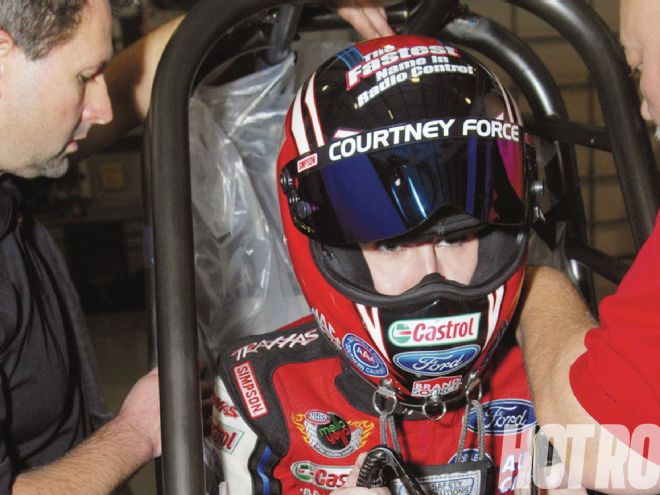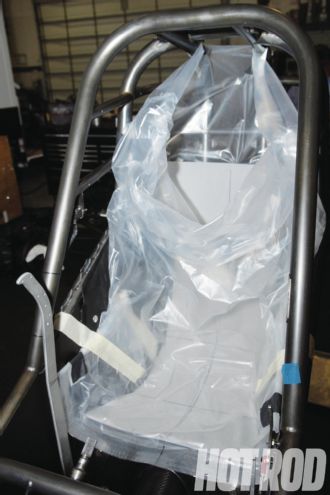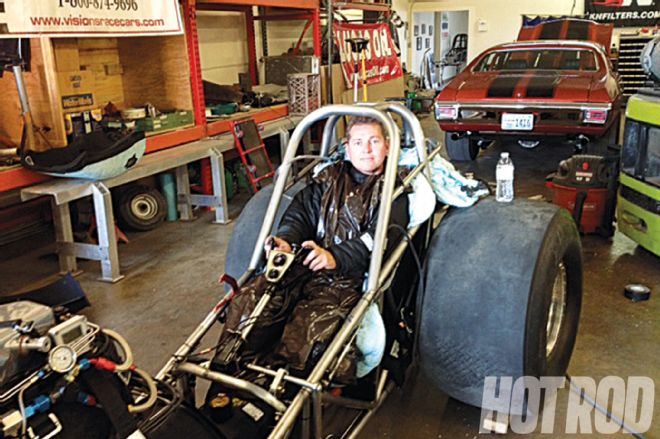
Peek in the cockpit of most top-level race cars and you might notice a lumpy, asymmetrical driver seat. It’s not poor fabrication; it’s good safety. “Pour in place” and “beaded foam” seat inserts are replacing traditional padded seats, and the result is not only safer in the event of a crash, it’s also more comfortable for the driver.
There are two different kinds of foam used for making the inserts. Kris VanGilder of Innovative Safety Products (ISP) uses a two-part expanding foam that is poured into a plastic bag around the driver, while they are supported in their preferred driving position. This foam has a very quick set-up time, only a few minutes while the driver is in place. Kris says a seat can be made in about four hours. Jeff Garvin of Garvin Motorsports prefers the beaded foam resin process. It’s slightly more complicated, requiring vacuum and an overnight set-up time, but Jeff says the longer work time allows him to form complex shapes like integrated armrests, and the driver doesn’t need to be in position for the whole process.
 Funny Car racer Courtney Force uses ISP seats, as do the other drivers at John Force Racing (JFR). She says they make a new seat every time they get a new car set up. The ISP process starts with a seat pan and some minimal padding.
Funny Car racer Courtney Force uses ISP seats, as do the other drivers at John Force Racing (JFR). She says they make a new seat every time they get a new car set up. The ISP process starts with a seat pan and some minimal padding.
The custom fit of the inserts eliminates the need for side bolsters or back padding--which can be time-consuming while suiting up for a race, and even worse, can come loose in a crash, leaving a driver unprotected from impact. Seat inserts are mandatory in IndyCar, NHRA pro classes, and most high-level road and circle-track applications, but the usage can vary from a small pad around the hips to a full-body support. Innovative Safety Products and Garvin may disagree about which foam is superior, but both agree that a full-body contoured seat insert will offer a driver better comfort and a more consistent seating position as well as improved cushioning in a crash.
“The foam we use fills all the voids between the driver’s body and the seat,” says Kris VanGilder (ISP). “Racing position, especially in a drag car, has most of the driver’s weight on the tailbone, a few vertebrae, and the shoulder blades. Crash testing showed that in an accident, or even under hard acceleration, a lot of pressure was on those few points of the body. If your head is supported but your back isn’t, you can still break your neck. Supporting the body evenly means all that pressure is spread out, and that protects against injury.”
Jeff Garvin of Garvin Motorsports adds that another benefit comes in the form of a more comfortable driver. “Their arm can be supported, that helps them keep the wheel straight on a launch. Their shoulders and hips can be kept in place no matter what lateral or g-forces that are acting on them. If you can get out of a car after a weekend of racing and go to work the next day with no back ache, no muscle strain--well, racing should be fun--you’re supposed to enjoy your car.”
Both companies cover the finished foam in fire-resistant materials and offer additional head restraints and other safety accessories. You can order a kit and make the insert yourself for around $400–$600, or, for about twice that, you can have a representative from ISP or Garvin Motorsports meet you at the track or at a shop and do the process for you.
 Nostalgia Fuel driver Adam Sorokin uses the Garvin MS seat. In this shot you can see him making an imprint in the foam bead and resin combo. “You can see I have a trash bag over my firesuit to protect it,” Adam says. “Once the bag is imprinted with my body and sets up, we can start taking the hot knife and sculpt out the seat to what we want. In my case, I like a minimal amount of seat. Just the back part.” After a final test fit, the seat will be smoothed out and upholstered in fire-retardant material.
Nostalgia Fuel driver Adam Sorokin uses the Garvin MS seat. In this shot you can see him making an imprint in the foam bead and resin combo. “You can see I have a trash bag over my firesuit to protect it,” Adam says. “Once the bag is imprinted with my body and sets up, we can start taking the hot knife and sculpt out the seat to what we want. In my case, I like a minimal amount of seat. Just the back part.” After a final test fit, the seat will be smoothed out and upholstered in fire-retardant material.